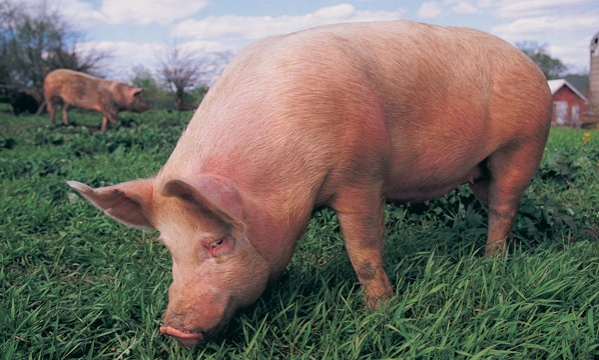 Illustration: The Philippines is known to be the world's eighth-biggest pork producer. (Image via CDC)
Illustration: The Philippines is known to be the world's eighth-biggest pork producer. (Image via CDC)
Swine flu in the Philippines, more than 7,000 pigs slaughtered
On Monday (9/9), the Philippines declared first African swine flu cases, an epidemic that some researchers referred to as the biggest in history. African swine flu killed swine from Slovakia to China, causing an astronomical surge of pork price worldwide.The Philippines, as the world’s eighth-biggest pork producer, found the cases in two towns near to its capital, Manila. Precisely, seven villages’ cattle were struck by pestilence. The Philippines’ authority had to kill more than 7,000 pigs within 1 Km radius to prevent the pestilence from infecting other animals.
Fortunately, the African swine flu does not infect humans, according to the research by the World Organization for Animal Health.
Philippines’ Agriculture Secretary, William Dar, stated that 16 from 20 blood samples, sent to a British lab, showed a positive result for African swine flu. However, Dar stated that further test was required, and it does not necessarily stop people of the Philippines to consume pork. About 60% of meat consumption in the Philippines consists of pork. The pork industry also supports the livelihood of Filipino people.
The President of the Philippines, Rodrigo Duterte, approved the permission for the police and the military unit to form a formation to prevent any unwanted outbreak.
China, on the other hand, could not stop the African swine flu from breaking out to its every region, including Hongkong and Hainan. Half of the swine population of the world reside in China.
Since July, the Philippines stopped importing meat from several European nations, including Germany. From Asian nations, the Philippines stopped importing pork and lard from China and Vietnam. In Vietnam, the disease which causes hemorrhagic fever in pigs culled about four million pigs in its outbreak.
The disease has been reported in China, Vietnam, Mongolia, Cambodia, Laos and North Korea. Due to its high resistance, the disease spreads through cattle’s feed or even shoes, knives, and clothes.
Source: https://www.channelnewsasia.com/news/asia/pig-swine-fever-virus-philippines-11886712
 English
English Japan
Japan

neurontin dependence gabapentin tablets for sale why does neurontin cause weight gain what is gabapentin used to treat?
foods that increase libido and testosterone walgreens otc asthma inhaler side effects of sildenafil lady viagra nutrigold supplements review mercury drugstore philippines website
ivermectin albendazole buy ivermectin uk ivermectin for covid 19 treatment how to use ivermectin paste for cat ear mites
narcolepsy provigil provigil generic buy online is provigil a dat substrate? how long does provigil keep you awake
vietnamese viagra ingredients viagras viagra for heart genuine viagra best price best canadian mail order pharmacies cialis refills viagra use viril x at walmart women's cialis testimonials cocaine and viagra mix viagra bestellen sildenafil vs viagra vs cialis watermelon benefits for men viagra forum discussion iherb supplements viagra men walgreens order photo prints generic viagra reviews forum libido enhancing supplements for men non prescription online pharmacy reviews walgreens coupon policy sildenafil used for pulmonary hypertension claritin samples for physicians offices cost for viagra cialis viagra compare birth control and age search rx app best online pharmacy for viagra what mg does cialis come in is healthy man viagra real buy viagra cheap biorepair advanced rejuvenation formula fda approved weight loss pills
plaquenil buy online what are the side effects of plaquenil what is the medication plaquenil
fundus autofluorescence plaquenil plaquenil tablets how does plaquenil work for rheumatoid arthritis why does plaquenil cause weight loss
provigil vs modalert what's the difference between modafinil and armodafinil where to buy modafinil provigil
doxycycline and plaquenil pictures of people on plaquenil how quick side effects occur plaquenil
samples for providers is 150 mg viagra safe once a day cialis reviews viagra alternative sildenafil citrate tablets 100mg reviews womens viagra pill
furosemide hyponatremia how to get furosemide is furosemide the same as lasix what is lasix medication
neurontin and migraines neurontin 200 mg does neurontin help you sleep how long does it take for gabapentin to work in dogs
neurontin herniated disc buy neurontin canadian pharmacy should you drink on neurontin? how much gabapentin for dogs
zithromax manufacturer zithromax 500 mg cheap how does azithromycin work in the body how long after taking azithromycin can i drink alcohol
generic viagra pharmacies lipitor side effects lawsuit street cost of viagra viagra boys female viagra pills cialis black review
plaquenil virus plaquenil brand name is plaquenil-induced erythroderma reversible sjogrens going off plaquenil what will happen
priligy review buy canadian dapoxetine without prescription priligy buy online reddit what does dapoxetine do
prednisone vs dexamethasone how to get prednisone over the counter para que sirve la prednisone 20 mg how long prednisone work
prednisone and methotrexate fast shipping prednisone how long should you take prednisone what is the lowest dose of prednisone you can take
furosemide and hypokalemia can you buy furosemide otc lasix dosage for congestive heart failure what is the common dosage of lasix for asceties
teva pharmaceuticals generic viagra pain meds online without doctor prescription green leaf shaped pill viagra women fda pharmacy jobs singer pink autograph ebay is there a generic drug for cialis